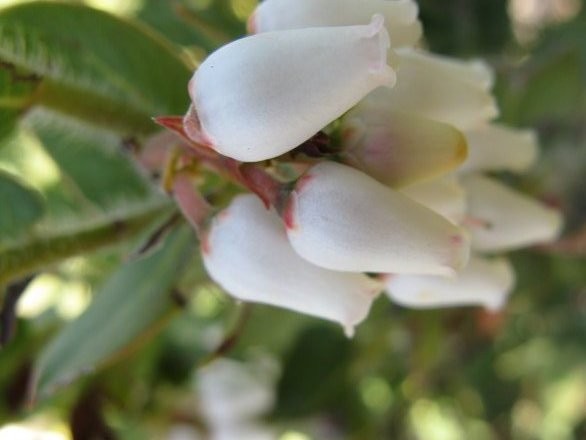Refugio manzanita
(Arctostaphylos refugioensis)

Description
Arctostaphylos refugioensis is a species of manzanita, known by the common name Refugio manzanita. It is endemic to Santa Barbara County, California, where it can be found along the immediate coastline, including the vicinity of Refugio State Beach, and into the Santa Ynez Mountains of the northwestern Transverse Ranges. Arctostaphylos refugioensis is a plant of the coastal sage and chaparral on sandstone soils. This is a shrub reaching at least 2 metres (6.6 ft) tall and known to exceed 4 metres (13 ft) in maximum height. Its branches are covered in long, gland-tipped bristles and a dense foliage of oblong greenish to deep red leaves. Each leaf is dull, waxy, and often bristly in texture, smooth or toothed along the edges, and up to 4.5 centimeters long. The shrub flowers in winter in inflorescences of cone-shaped manzanita flowers each up to a centimeter long. The fruit is a spherical to oval red drupe with a pointed end, measuring at least a centimeter long. Arctostaphylos is a genus of plants comprising the manzanitas and bearberries. They are shrubs or small trees. There are about 60 species, of Arctostaphylos, ranging from ground-hugging arctic, coastal, and mountain species to small trees up to 6 m tall. Most are evergreen (one species deciduous), with small oval leaves 1–7 cm long, arranged spirally on the stems. The flowers are bell-shaped, white or pale pink, and borne in small clusters of 2–20 together; flowering is in the spring. The fruit are small berries, ripening in the summer or autumn. The berries of some species are edible. Arctostaphylos species are used as food plants by the larvae of some Lepidoptera species including Coleophora arctostaphyli (which feeds exclusively on A. uva-ursi) and Coleophora glaucella. Manzanitas, the bulk of Arctostaphylos species, are present in the chaparral biome of western North America, where they occur from southern British Columbia in Canada, Washington to California and New Mexico in the United States, and throughout much of northern and central Mexico. Three species, the bearberries, A. alpina (alpine bearberry), A. rubra (red bearberry) and A. uva-ursi (common bearberry), have adapted to arctic and subarctic climates, and have a circumpolar distribution in northern North America, Asia and Europe.
Taxonomic tree:







